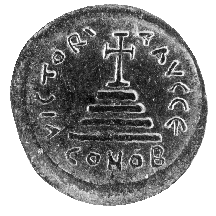



(133) Tiberius Constantine - AV solidus, A.D. 578-582, 4.40 g.
(inv. 91.272).
Obverse: Facing cuirassed bust of Tiberius Constantinius,
wearing crown with cross and holding globus cruciger in r.; at left
shoulder, shield depicting attacking horseman; D(OMINVS) N(OSTER) TIB(ERIVS)
CONSTAN(TINI)VS P(ER)P(ETVVS) AVC(VSTVS): Our lord Tiberius Constantine,
perpetual Augustus.
Reverse: Cross potent on four steps; VICTORIA AVCC (AVGVSTORVM
abbreviated) E: Victory of the Augusti, officina mark E; in exergue,
CONOB: gold of Constantinople.
Provenance: Ex Milton Holmes collection, 1960.
Bibliography: W. Wroth, Catalogue of the Imperial Byzantine
Coins in the British Museum (London 1908); P. Grierson, Byzantine
Coins (London 1982).
Tiberius I was made Caesar by Justin II in A.D. 574 and renamed Tiberius
Constantine. When Justin suffered bouts of insanity, he appointed Tiberius
his successor. Tiberius inherited Justin's problems, including the war with
the Persians that had begun under Justin, and he was only able to hold the
Persians at bay.
For the history of Byzantine coinage, Tiberius plays an important role.
He introduced a new reverse type, the cross potent (a cross with a bar at
the end of each arm) on four steps, a radical change from the figural types
of earlier coinage. The image supposedly came to him in a vision. The cross
on the steps is called the cross calvary because it is assumed to refer
to the cross on the hill of Calvary. The immediate inspiration for the image
may have been the golden cross that was erected on Mount Calvary in the
reign of Theodosius II (A.D. 408-450). Although the type was used only once
in sixth-century coinage, it was often used during the seventh and eighth
centuries.
T.S.R.



All contents copyright (c) 1996.
Lawrence University
All rights reserved.